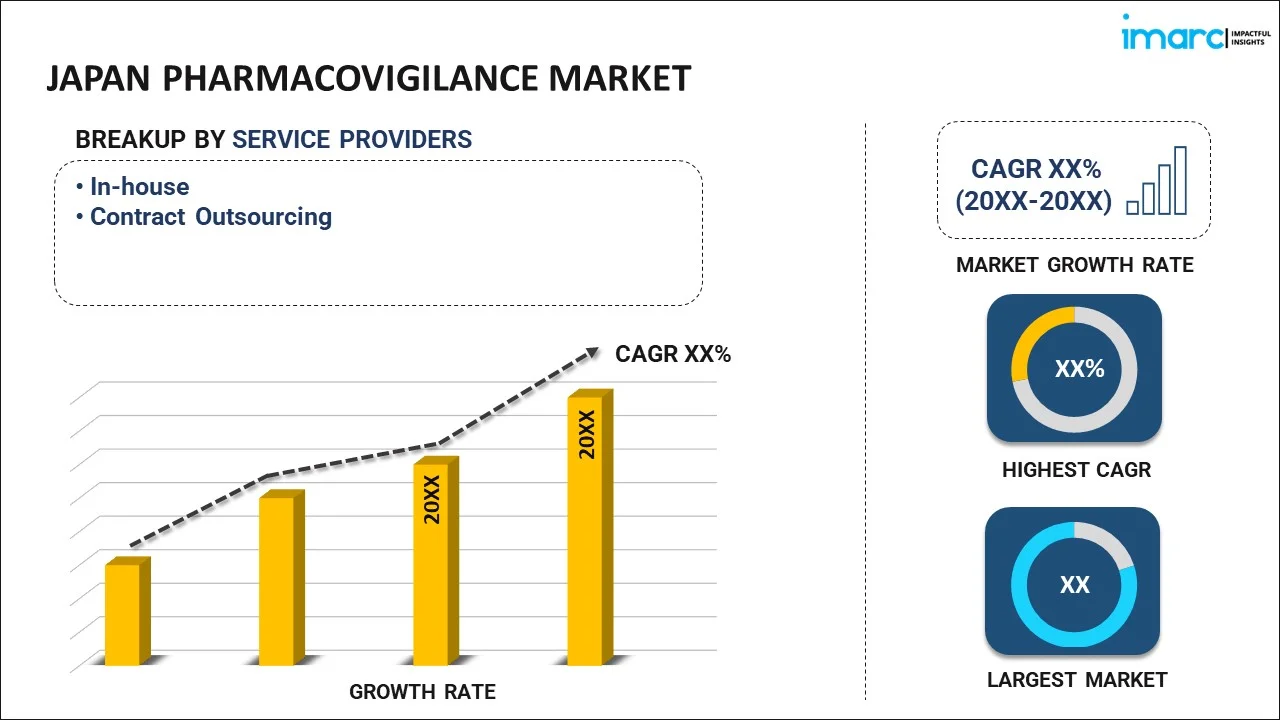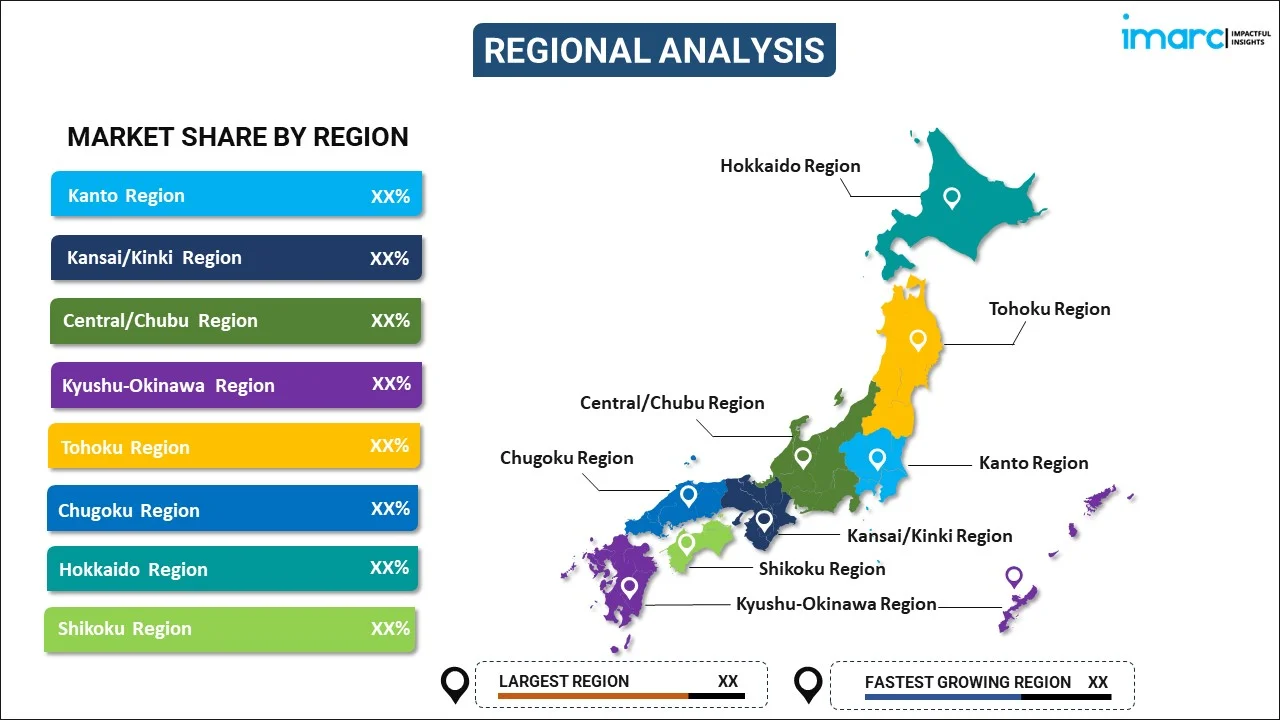
Japan Pharmacovigilance Market Report by Service Provider (In-house, Contract Outsourcing), Product Life Cycle (Pre-clinical, Phase I, Phase II, Phase III, Phase IV), Type (Spontaneous Reporting, Intensified ADR Reporting, Targeted Spontaneous Reporting, Cohort Event Monitoring, EHR Mining), Process Flow (Case Data Management, Signal Detection, Risk Management System), Therapeutic Area (Oncology, Neurology, Cardiology, Respiratory Systems, and Others), End Use (Pharmaceuticals Companies, Biotechnology Companies, Medical Device Companies, and Others), and Region 2025-2033
Market Overview:
Japan pharmacovigilance market size reached USD 502.7 Million in 2024. Looking forward, IMARC Group expects the market to reach USD 976.1 Million by 2033, exhibiting a growth rate (CAGR) of 7.70% during 2025-2033. The increasing demand for big data analytics, artificial intelligence, and machine learning tools, which has revolutionized pharmacovigilance by enabling more efficient signal detection and risk assessment, is driving the market.
|
Report Attribute
|
Key Statistics
|
|---|---|
|
Base Year
|
2024 |
|
Forecast Years
|
2025-2033
|
|
Historical Years
|
2019-2024
|
| Market Size in 2024 | USD 502.7 Million |
| Market Forecast in 2033 | USD 976.1 Million |
| Market Growth Rate (2025-2033) | 7.70% |
Pharmacovigilance is a crucial aspect of healthcare and drug regulation. It involves the systematic monitoring, assessment, and reporting of adverse effects and safety concerns associated with pharmaceutical products, including prescription medications, vaccines, and over-the-counter drugs. The primary goal of pharmacovigilance is to ensure the safety and effectiveness of these products throughout their lifecycle. Healthcare professionals, pharmaceutical companies, and regulatory agencies collaborate in this process. They collect and analyze data on adverse events and side effects reported by patients and healthcare providers. If a potential safety concern arises, appropriate actions, such as product labeling updates, warnings, or even product recalls, may be taken to protect public health. Pharmacovigilance helps identify previously unknown or rare adverse effects, ensuring that drugs on the market remain safe for patients. This ongoing monitoring and risk assessment contribute to the continuous improvement of drug safety and the overall quality of healthcare.
Japan Pharmacovigilance Market Trends:
The pharmacovigilance market in Japan is experiencing robust growth, primarily due to several interconnected drivers. Firstly, the escalating regional demand for healthcare services has led to an increased consumption of medicines, amplifying the need for vigilant monitoring of drug safety. Additionally, the rising prevalence of chronic diseases and the introduction of new and complex therapies have further fueled the expansion of the pharmacovigilance market. Moreover, regulatory agencies in Japan are tightening their oversight of drug safety, imposing stringent reporting requirements on pharmaceutical companies. This has necessitated the outsourcing of pharmacovigilance activities to specialized service providers, driving market growth. Simultaneously, the growing awareness among healthcare professionals and patients about the importance of adverse event reporting has led to increased pharmacovigilance efforts. Moreover, advancements in technology, including artificial intelligence and big data analytics, which have revolutionized pharmacovigilance by enhancing the efficiency and accuracy of adverse event detection, are expected to drive the market in Japan during the forecast period.
Japan Pharmacovigilance Market Segmentation:
IMARC Group provides an analysis of the key trends in each segment of the market, along with forecasts at the country level for 2025-2033. Our report has categorized the market based on service provider, product life cycle, type, process flow, therapeutic area, and end use.
Service Provider Insights:

- In-house
- Contract Outsourcing
The report has provided a detailed breakup and analysis of the market based on the service provider. This includes in-house and contract outsourcing.
Product Life Cycle Insights:
- Pre-clinical
- Phase I
- Phase II
- Phase III
- Phase IV
A detailed breakup and analysis of the market based on the product life cycle have also been provided in the report. This includes pre-clinical, phase i, phase ii, phase iii, and phase iv.
Type Insights:
- Spontaneous Reporting
- Intensified ADR Reporting
- Targeted Spontaneous Reporting
- Cohort Event Monitoring
- EHR Mining
The report has provided a detailed breakup and analysis of the market based on the type. This includes spontaneous reporting, intensified ADR reporting, targeted spontaneous reporting, cohort event monitoring, and EHR mining.
Process Flow Insights:
- Case Data Management
- Case Logging
- Case Data Analysis
- Medical Reviewing and Reporting
- Signal Detection
- Adverse Event Logging
- Adverse Event Analysis
- Adverse Event Review and Reporting
- Risk Management System
- Risk Evaluation System
- Risk Mitigation System
A detailed breakup and analysis of the market based on the process flow have also been provided in the report. This includes case data management (case logging, case data analysis, and medical reviewing and reporting), signal detection (adverse event logging, adverse event analysis, and adverse event review and reporting), and risk management system (risk evaluation system and risk mitigation system).
Therapeutic Area Insights:
- Oncology
- Neurology
- Cardiology
- Respiratory Systems
- Others
The report has provided a detailed breakup and analysis of the market based on the therapeutic area. This includes oncology, neurology, cardiology, respiratory systems, and others.
End Use Insights:
- Pharmaceuticals Companies
- Biotechnology Companies
- Medical Device Companies
- Others
A detailed breakup and analysis of the market based on the end use have also been provided in the report. This includes pharmaceuticals companies, biotechnology companies, medical device companies, and others.
Regional Insights:

- Kanto Region
- Kansai/Kinki Region
- Central/ Chubu Region
- Kyushu-Okinawa Region
- Tohoku Region
- Chugoku Region
- Hokkaido Region
- Shikoku Region
The report has also provided a comprehensive analysis of all the major regional markets, which include Kanto Region, Kansai/Kinki Region, Central/ Chubu Region, Kyushu-Okinawa Region, Tohoku Region, Chugoku Region, Hokkaido Region, and Shikoku Region.
Competitive Landscape:
The market research report has also provided a comprehensive analysis of the competitive landscape. Competitive analysis such as market structure, key player positioning, top winning strategies, competitive dashboard, and company evaluation quadrant has been covered in the report. Also, detailed profiles of all major companies have been provided.
Japan Pharmacovigilance Market Report Coverage:
| Report Features | Details |
|---|---|
| Base Year of the Analysis | 2024 |
| Historical Period | 2019-2024 |
| Forecast Period | 2025-2033 |
| Units | Million USD |
| Scope of the Report | Exploration of Historical and Forecast Trends, Industry Catalysts and Challenges, Segment-Wise Historical and Predictive Market Assessment:
|
| Service Providers Covered | In-house, Contract Outsourcing |
| Product Life Cycles Covered | Pre-clinical, Phase I, Phase II, Phase III, Phase IV |
| Types Covered | Spontaneous Reporting, Intensified ADR Reporting, Targeted Spontaneous Reporting, Cohort Event Monitoring, EHR Mining |
| Process Flows Covered |
|
| Therapeutic Area Covered | Oncology, Neurology, Cardiology, Respiratory Systems, Others |
| End Uses Covered | Pharmaceuticals Companies, Biotechnology Companies, Medical Device Companies, Others |
| Regions Covered | Kanto Region, Kansai/Kinki Region, Central/ Chubu Region, Kyushu-Okinawa Region, Tohoku Region, Chugoku Region, Hokkaido Region, Shikoku Region |
| Customization Scope | 10% Free Customization |
| Post-Sale Analyst Support | 10-12 Weeks |
| Delivery Format | PDF and Excel through Email (We can also provide the editable version of the report in PPT/Word format on special request) |
Key Questions Answered in This Report:
- How has the Japan pharmacovigilance market performed so far and how will it perform in the coming years?
- What has been the impact of COVID-19 on the Japan pharmacovigilance market?
- What is the breakup of the Japan pharmacovigilance market on the basis of service provider?
- What is the breakup of the Japan pharmacovigilance market on the basis of product life cycle?
- What is the breakup of the Japan pharmacovigilance market on the basis of type?
- What is the breakup of the Japan pharmacovigilance market on the basis of process flow?
- What is the breakup of the Japan pharmacovigilance market on the basis of therapeutic area?
- What is the breakup of the Japan pharmacovigilance market on the basis of end use?
- What are the various stages in the value chain of the Japan pharmacovigilance market?
- What are the key driving factors and challenges in the Japan pharmacovigilance?
- What is the structure of the Japan pharmacovigilance market and who are the key players?
- What is the degree of competition in the Japan pharmacovigilance market?
Key Benefits for Stakeholders:
- IMARC’s industry report offers a comprehensive quantitative analysis of various market segments, historical and current market trends, market forecasts, and dynamics of the Japan pharmacovigilance market from 2019-2033.
- The research report provides the latest information on the market drivers, challenges, and opportunities in the Japan pharmacovigilance market.
- Porter's five forces analysis assist stakeholders in assessing the impact of new entrants, competitive rivalry, supplier power, buyer power, and the threat of substitution. It helps stakeholders to analyze the level of competition within the Japan pharmacovigilance industry and its attractiveness.
- Competitive landscape allows stakeholders to understand their competitive environment and provides an insight into the current positions of key players in the market.
Need more help?
- Speak to our experienced analysts for insights on the current market scenarios.
- Include additional segments and countries to customize the report as per your requirement.
- Gain an unparalleled competitive advantage in your domain by understanding how to utilize the report and positively impacting your operations and revenue.
- For further assistance, please connect with our analysts.
 Inquire Before Buying
Inquire Before Buying
 Speak to an Analyst
Speak to an Analyst
 Request Brochure
Request Brochure
 Request Customization
Request Customization




.webp)




.webp)












